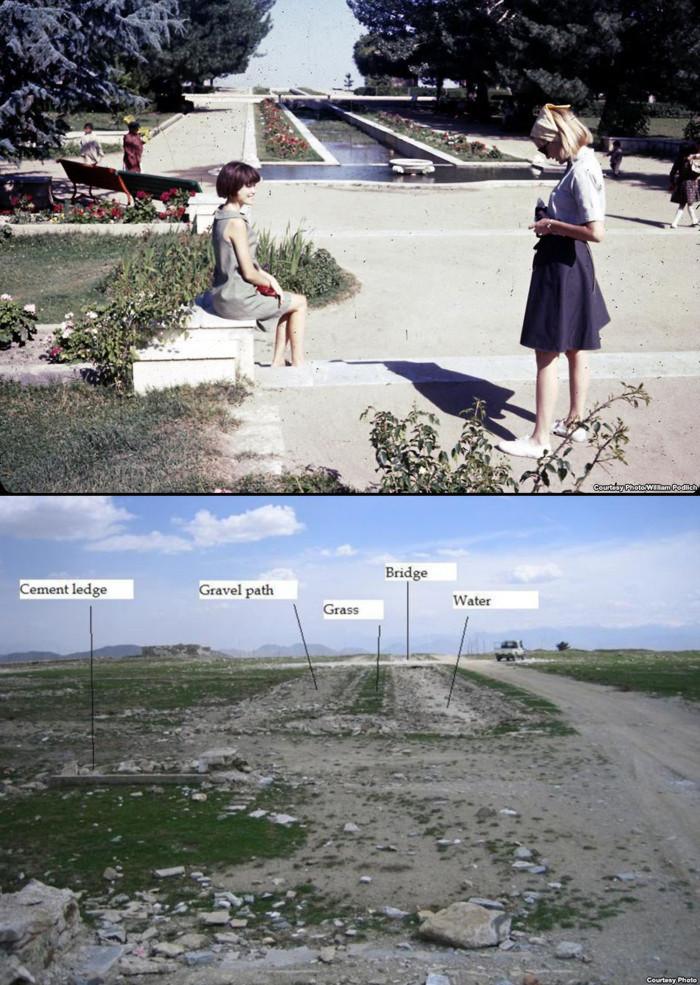By Grant Podelco
In early February, "Picture This" ran a photo gallery titled "Afghanistan As It Once Was." The photographs were taken in Kabul in the late 1960s by William Podlich, a professor at Arizona State University. Podlich, a camera buff, spent two years in Afghanistan -- teaching and taking pictures. His daughter, Peg Podlich, was kind enough to share some of her father's photos with RFE/RL. Peg's husband, Clayton Esterson, maintains a website dedicated to preserving his father-in-law's archives.
And it was on Esterson's blog that we first came across this shocking set of before-and-after photos of Paghman Gardens, located some 15 kilometers outside of the Afghan capital.

Like many of his friends, Hashem Mohmand, the director of RFE/RL’s Radio Free Afghanistan, used to spend a lot of time at Paghman Gardens when he was growing up in Afghanistan in the late 1960s and early '70s. He remembers an idyllic landscape where he and his friends would picnic to escape the heat of the capital. “I remember this place very well,” he says. “During the civil war, the Islamic unity group under Abdul Rasul Sayaf had its military headquarters on top of the hill and the fighters of the rival Islamic party of Gulbuddin Hekmatyar were also present close to this area. They cut the trees and burned them.(Top photo: William Podlich)
More Photos of Paghman
The first photo (below) shows Peg Podlich apparently taking a photograph of her sister Jan as she poses sitting on a wall in Paghman Gardens. Tall pine trees tower in the background. Flowers and shrubs bloom amid neatly trimmed grass that borders a long reflecting pool. Paths lead off through the greenery in all directions.
The second photo was taken from almost the exact same spot as the Podlich picture about five years ago by Jon Nyswonger and provided to Clayton and Peg.
The trees are gone. The reflecting pool has disappeared. Even the pathways have been reduced to rubble. The remains of the wall on which Jan was sitting might even be visible in the lower left of the photo.
Like many of his friends, Hashem Mohmand, the director of RFE/RL’s Radio Free Afghanistan, used to spend a lot of time at Paghman Gardens when he was growing up in Afghanistan in the late 1960s and early '70s. He remembers an idyllic landscape where he and his friends would picnic to escape the heat of the capital.
“Everything was beautiful,” Mohmand recalls. “There were exotic flowers and interesting plants from different countries. And lots of nice-looking girls walking around. And the weather was nice in the summer. It was much cooler in the gardens than in Kabul.”
Mohmad says the area shown in the photographs is known as the top of Paghman Hill.
“I remember this place very well,” he says. “During the civil war, the Islamic unity group under Abdul Rasul Sayaf had its military headquarters on top of the hill and the fighters of the rival Islamic party of Gulbuddin Hekmatyar were also present close to this area. They cut the trees and burned them.
“My colleagues who have visited Paghman one or two years ago say that in recent years many saplings have been planted there and it looks a little different now.”
Side by side, the two photographs are a sobering reminder of how 30 years of war can ravage a countryside and scar a nation's memories.



